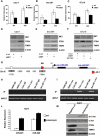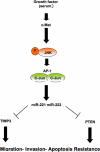RETRACTED: miR-221&222 regulate TRAIL resistance and enhance tumorigenicity through PTEN and TIMP3 downregulation
- PMID: 19962668
- PMCID: PMC2796583
- DOI: 10.1016/j.ccr.2009.10.014
RETRACTED: miR-221&222 regulate TRAIL resistance and enhance tumorigenicity through PTEN and TIMP3 downregulation
Retraction in
-
Retraction Notice to: miR-221&222 Regulate TRAIL Resistance and Enhance Tumorigenicity through PTEN and TIMP3 Downregulation.Cancer Cell. 2022 Nov 14;40(11):1440. doi: 10.1016/j.ccell.2022.10.005. Epub 2022 Oct 27. Cancer Cell. 2022. PMID: 36306794 Free PMC article. No abstract available.
Abstract
This article has been retracted: please see Elsevier Policy on Article Withdrawal (http://www.elsevier.com/locate/withdrawalpolicy). This article has been retracted at the request of the editors. This article was published on December 8, 2009. In November 2021, The Ohio State University notified the Cancer Cell editors that this article contains ten instances of plagiarized text; that Figures 1G, 5B, 5E, 7D, and 7F were falsified; and that part of Figure 1G in the article is the same as part of Figure 1B in another article that was later retracted (Garofalo et al., 2008, PLOS One 3, e4070, https://doi.org/10.1371/journal.pone.0004070). The university recommended the editors correct or retract the article. Given the extent and severity of these issues, the editors are retracting the article. S.-S. S. agrees with the retraction, and M.G., G.D.L., G.N., F.P., P.S., P.G., G.C., and C.M.C. disagree with the retraction; all other authors couldn't be reached or didn't respond.
Figures








References
-
- Ahonen M, Baker AH, Kähäri VM. Adenovirus-mediated gene delivery of tissue inhibitor of metalloproteinases-3 inhibits invasion and induces apoptosis in melanoma cells. Cancer Res. 1998;58:2310–5. - PubMed
-
- Ambros V. The functions of animal microRNAs. Nature. 2004;431:350–5. - PubMed
-
- Bartel DP. MicroRNAs: genomics, biogenesis, mechanism, and function. Cell. 2004;116:281–97. - PubMed
Publication types
MeSH terms
Substances
Grants and funding
LinkOut - more resources
Full Text Sources
Other Literature Sources
Molecular Biology Databases
Research Materials

